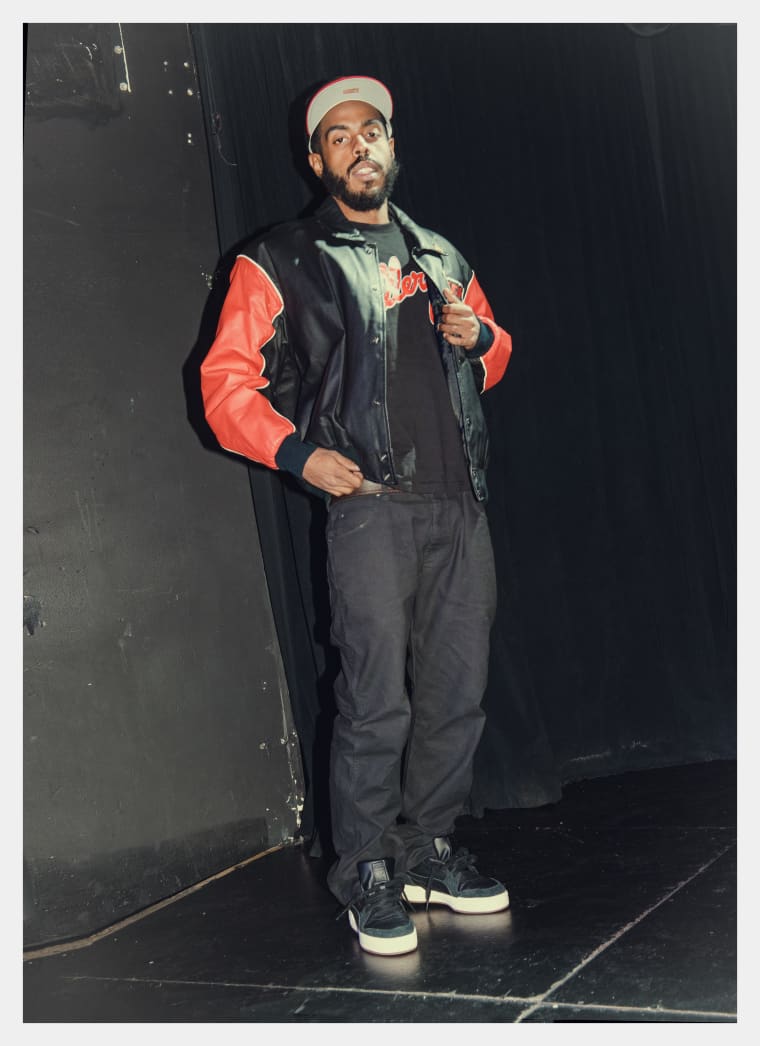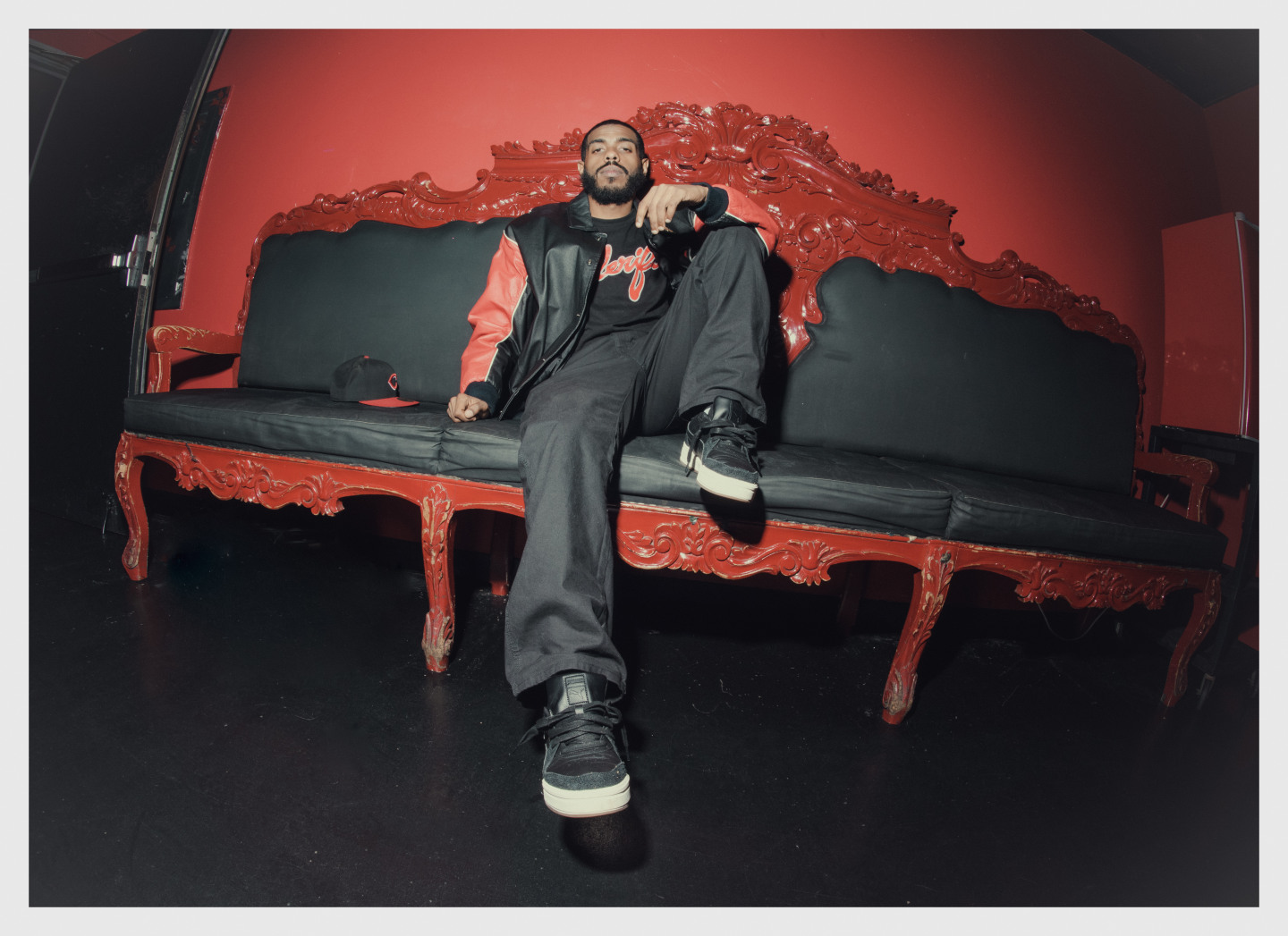When Papo2oo4 describes the wardrobes he saw growing up, you can picture every piece: the baggy jeans, the fitted hats with military rigidity, the maybe-fake earrings so big they seem to have their own gravitational pull. But it wasn’t really the clothing that the New York-born rapper, who has recently revealed himself as one of the underground’s most inventive synthesists, coveted. “It was more a mentality,” he says, “Somebody that’s not going to fold to the new stuff: ‘He on some ‘04 s---.’”
Fashion has always been central to hip-hop culture, a vehicle for self-expression and creativity. Where Papo and his friends identified certain outfits as relics from a bygone era, other pieces — like the iconic PUMA Classic sneakers he’s wearing today — are staples that evolve with the world around them, a link to the past that points relentlessly forward.
It’s with a similar spirit of connecting the past to the present that gave Papo and his close circle of friends and collaborators, including his go-to producer Subjxct 5, their name: the 2oo4 collective. But while Papo’s music often recalls the misanthropic mixtape rap of New York in that period, it also evokes the wild west that was the internet of the early 2010s, in the time before digital streaming platforms, when each click sent you plummeting deeper down a rabbit hole. Remarkably prolific — he’s released eight full-length projects in the last two years alone — Papo grinds familiar markers of the past into a new alloy as disorienting as it is magnetic.
Papo grew up first in Washington Heights, blocks away from the Harlem that was producing the rap he gravitated toward as an adolescent. Ready to Die, by Bed-Stuy native The Notorious B.I.G., had been something of a big bang for him as a child, but it was post-Y2K Harlemites like Jae Millz and Vado who made hip-hop intoxicating. (His love for that neighborhood’s school of swaggering trash-talk rap wasn’t without discernment, though: “I wasn’t really a Juelz guy,” he says of Juelz Santana, the never-quite heir to Cam’ron’s nursery rhymes-though-a-looking glass throne. “It was feeling predictable for me — and I was like, 12.”) As rap music was evolving outside his window, some things remained constant, like the Puma Classics which had completed outfits since their debut in 1968, and later become a go-to for the hip-hop community.
Papo’s pride in the local product was augmented by recommendations from his neighbor, Anderson Hernandez, who would go on to be known as the producer Vinylz, a frequent collaborator with Boi-1da who has crafted beats for Jay-Z, Drake, and Lil Wayne. “Him and his brother would put me onto everything,” Papo recalls of the otherwise unknown rappers whose names kept popping up on sites like NahRight and 2DopeBoyz. Thanks to the proliferation of file-sharing sites and mp3 blogs — and also, ironically, to the decisions made by New York’s own Jay-Z during his tenure as president of Def Jam — rap’s balance of power in the 2000s eventually drifted south, away from the five boroughs. This didn’t bother Papo or make him defensive — “Jeezy’s one of my top guys,” he says, recounting the ubiquity of 2005’s Def Jam-issued, Jay-featuring Let’s Get It: Thug Motivation 101 — and before long he had left the city too, at least technically.
When Papo was a teenager, he and his family moved a few miles southeast, to Elizabeth, New Jersey. Last year, on a song called “Meeting House Rd” from Continuous Improvement, a collaborative project with Subjxct 5 and DJ Lucas, he rapped of the move:
We was living in the Heights, all we seen was the lights
Hearing sirens, watching hood rats fight
Moved to Jersey where them nights is dark
Stay alert, and you better be sharp


“People don’t be outside,” Papo says of his impression upon moving to Jersey. “Not like New York. The sun goes down and everyone’s in the house. Only the stickup kids is out.” Without Vinylz, Papo was left to comb through blogs on his own. Which he did: he remembers fondly the seemingly endless string of video interviews in which a post-jail Max B dissed his estranged mentor Jim Jones. This was at the time when Max, with his syrup atonality, had become “everybody’s favorite rapper.” Hip-hop has long been unique for its way to make the most specific, innovative details become flashes of universal recognition. As the genre celebrates its 50th anniversary, timeless looks led by PUMA Classics sneakers have become the stuff of legend — and fodder for constant rejuvenation and reimagination.
Fortunately, the sense of isolation that struck Papo upon moving to Elizabeth didn’t last long. He found a network of friends which soon morphed into a cadre of aspiring artists and producers, including Subjxct 5. “I used to make fun of people who tried to rap,” Papo says, “Like: ‘look at this guy handing out CDs in Times Square.’” But he was enamored with the demos his friends were cutting, and was eventually the one who encouraged them to take the process more seriously. The formless, Fabolous- and Lloyd Banks-indebted punchline raps he had scribbled in math notebooks gave way to the Harlem-adjacent trash-talk that seemed truer to his personality and experience. That refined writing is filtered through a voice that recalls a couple stars of the past — and one with a particular significance. “I layer my vocals: I’ll do one and then a double, but I want the double to be a little off, like 2Pac or Max B,” he says. “And then my voice be kinda raspy, so it gives it some texture.”
Even someone who had never heard that voice could scan Papo’s release names (sample title: Pap on P.E.Ds) and clock him as a massive sports fan. A former basketball obsessive who was born on the same day as Barry Bonds — “Bro, he was too crazy,” he says of the embattled seven-time NL MVP, “even when he was skinny Bonds” — Papo dots his raps with references to athletes who were (or were becoming) stars right around that 2004 sweet spot. And yet, as is the case with his music, he doesn’t cling to nostalgia for any one era: he argues that the NBA, with its increased parity and wider distribution of superstars, is better now than it has been in some time.
To that point, when I ask Papo if he could pick any rapper in any given year to trade verses with on a song, he reaches back not to the W. Bush years, but much further. “Oh, Slick Rick” he says. “Slick Rick in ‘88 — ‘Mona Lisa’ Slick Rick. That’s the Super Saiyan rapper.” Though this seems, at first, discordant with his major influences, it’s easy on closer examination to see why Papo would feel a kinship to the Ruler, an MC positively dripping in style and seemingly impervious to the trends of the moment. When you strip away the signifiers of one period, the detritus of another, you’re left with a single, enduring truth: being nice is forever. In the same way that PUMA Classics, for example, can be styled with any look, the calling cards of past styles can be repurposed to new ends in the studio. For as rooted as his music is in the culture of the early 2000s and the grainy digital dystopia of the early 2010s, it’s also a style that stakes itself on execution — on being sharper, hungrier, more colorful than the next artist. In Papo2oo4’s music, there is refuge in the past, but there’s no place to hide.
The PUMA CA Pro worn by Papo2oo4 throughout this article are available now at JD Sports.






